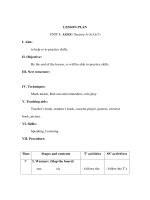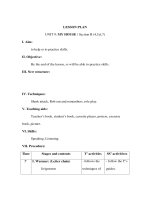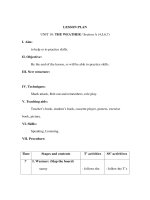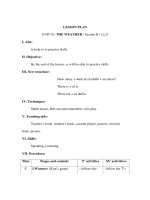Khung giao an tieng anh lop 3 cua nha xuat ban giao duc viet nam
Bạn đang xem bản rút gọn của tài liệu. Xem và tải ngay bản đầy đủ của tài liệu tại đây (391.88 KB, 12 trang )
TiÕng Anh 3
School Year 2014 - 2015
GETTING STARTED
THE 4 MAIN APPROACHES
Objective: Communicative language competence approach
Content: Thematic approach
Methodology: Leaning-centered approach
Outcome: Equivalent to level A1 of CEFR
TOPIC I: THE OBJECTIVES
Communicative approach: 5 skills + 3 language elements
Spoken
(Dicisive)
LISTENING
Writen
(Supportive)
Language
(Conditional)
SPOKEN INTERACTION
READING
SPEAKING
WRITING
PHONICS + VOCABULARY + FUNTIONS
TOPIC II: THE CONTENT
I. THE CURRICULUM
4 themes: 20 topics (20 units) + 4 reviews + 4 tests
Me & my friends
Five topics (Units) + Review 1 + Middle-term Test 1
Me & my school
Five topics (Units) + Review 2 + Term Test 1
Me & my family
Five topics (Units) + Review 3 + Middle-term Test 2
Me & the world around us
Five topics (Units) + Review 4 + Term Test 2
Yen Dong B Primary School
§Æng ThÕ Tµi
1
TiÕng Anh 3
School Year 2014 - 2015
II. THE STUDENT’S BOOK
1. The book-map
THEME 1: ME AND MY FRIENDS
Unit 1. Hello!
Competences
Sentence Patterns
Vocabulary
(Năng lực giao tiếp)
- Greeting & self- Hello / Hi. I’m Mai.
Hello / hi
introducing (C1-L1)
- How are you? I’m
goodbey / bye
- Greeting & responding to fine. Thank you. /
greeting (C1-L1)
Thanks.
Phonics
bye
hello
2. The units
Lesson 1:
Competence 1
Page 1 / Period 1
1. Look, listen & repeat
2. Point & say
3. Let’s talk
Lesson 2:
Competence 2
Page 3 / Period 3
1. Look, listen & repeat
2. Point & say
3. Let’s talk
Lesson 3:
Language focus
Page 5 / Period 5
1. Listen & repeat (phonics)
2. Listen & write
3. Let’s chant
Page 2 / Period 2
4. Listen & tick
5. Let’s write
(words & structures)
6. Let’s sing
Page 4 / Period 4
4. Listen & number
5. Let’s write
(words & structures)
6. Reading …
Page 6 / Period 6
4. Read & match (functions)
5. Writing …
(about you)
6. Project
III. THE TEACHING PLANS
Lesson 1
Period 1/
Page 1
Period 2/
Page 2
Lesson 2
Period 3/
Page 3
Period 4/
Page 4
Lesson 3
Period 5/
Page 5
Period 6/
Page 6
4 periods per week
1. Look, listen & repeat
2. Point & say
3. Let’s talk
4. Listen & tick
5. Let’s write
6. Let’s sing
1. Look, listen & repeat
2. Point & say
3. Let’s talk
4. Listen & number
5. Let’s write
6. Reading
1. Listen & repeat
2. Listen & write
3. Let’s chant
4. Read & match
5. Writing …
6. Project
Yen Dong B Primary School
§Æng ThÕ Tµi
2
Spoken interaction
Words & structure
Listening
Words & structures
Spoken interaction
Words & structure
Listening
Words & structures
Phonics
Functions
Writing.
TiÕng Anh 3
School Year 2014 - 2015
2 periods per week
Lesson 1
Period 1/
Page 1
Lesson 2
Period 2/
Page 3
Lesson 3
Period 3/
Page 5
Lesson 1
Period 1/
Page 1
Lesson 2
Period 2/
Page 3
Lesson 3
Period 3/
Page 5
Period 4/
Pages
(2, 4, 6)
1. Look, listen & repeat
2. Point & say
3. Let’s talk
1. Look, listen & repeat
2. Point & say
3. Let’s talk
1. Listen & repeat
2. Listen & write
3. Let’s chant
3 periods per week
1. Look, listen & repeat
2. Point & say
3. Let’s talk
1. Look, listen & repeat
2. Point & say
3. Let’s talk
1. Listen & repeat
2. Listen & write
3. Let’s chant
4. Listen & tick or 4. Listen & number
(L2, L3)
4. Read & match
6. Reading
5. Writing …(about you)
Spoken interaction
Words & structures
Spoken interaction
Words & structures
Phonics
Spoken interaction
Words & structures
Spoken interaction
Words & structures
Phonics
TOPIC III: THE METHODOLOGY
The approach: W.W.H (Who learn What and How)
Who
LearnerSs are those who learn
centered
Learning actively, creatively, whole-heartedly
learning
Learning how to learn
What
Task-based
Learning strategies through:
learning
Many different texts / tasks / activities / for 5 skills and 3
language elements
Chants / songs / games / projects
How
Learning- Methods:
centered
Methods: What methods are used
learning
Procedures: How many steps & how they are formed
Techniques: What techniques & how they are used
- Modes:
Management: How the activitiy / tasks is managed
Inter-interaction: How Ss interact with each other
Outer-interaction: How Ss interact with teachers / books /
materials
Yen Dong B Primary School
§Æng ThÕ Tµi
3
TiÕng Anh 3
School Year 2014 - 2015
I. THE TEXT / TASK / ACTIVITY
1. The G. I. P. O
Goal + Input (Context-Content-Model) + Process + Outcome
Goal: Things that Ss will be able to achieve by the end of the activity / task
Input: - Context: The questions of Who / What / Where / When, …
- Content: The language focus (Phonics or Vocabulary or Structures or
Functions)
- Model: The sample / example
Process: The steps Ss have to follow
Outcome: Things that Ss CAN DO
2. The steps and learning activities: G
( Getting started
Steps (1)
Getting
started
D
Doing the task / activity
Components (2)
Goal:
Context:
Content:
Model:
Doing
Process
Performing Outcome
P
Performing the task / activity)
Learning activities (2)
Introducing what Ss will be able to achieve
Asking and answering the questions of who / what /
where / when, … to understand the context
Introducing the main language focus (phonics or
words or structures / functions)
Looking, listening and repeating the sample
The steps of Doing the task / activity
Applying new language in a new contexts
Performing / Responding what Ss CAN DO
3. The language focus:
(Phonics or Vocabulary or Structures / Functions)
Steps (1)
Getting
started
Learning activities (2)
Goal
Context
Content
Model
Doing
Steps of Doing the task / activity
Performing Applying new language in a new contexts
Performing / Responding the Outcome
Yen Dong B Primary School
§Æng ThÕ Tµi
4
Language focus (3)
Phonics or Vocabulary or
Structures / Functions
TiÕng Anh 3
School Year 2014 - 2015
4. The modes:
(Whole class
Steps (1)
Getting
started
Doing
Individual
pair
group
Learning activities (2)
Goal
Context
Content
Models
Doing the task individually
in pairs
in groups
Performing Applying new language in a new contexts
Performing / Responding the Outcome
whole class)
Modes (4)
Whole class
(1st round)
Individual work
Pair-work
Group-work
(2nd round)
(3rd round)
(4th round)
Whole class
(5th round)
5. The 4 elements:
(Steps + Learning activities + Language focus + Modes)
Steps (1)
Getting
started
Doing
Learning activities (2)
Goal
Context
Content
Model
Doing the task
Language
focus (3)
Modes (4)
Whole class
Phonics or
Vocabulary or
Structures /
Functions
Performing Applying new language in a new contexts
Performing / Responding the Outcome
Individuals
Pairs
Groups
Whole class
II. THE LESSON PLAN
OVERVIEW: 3 components
1. Objectives:
Ss will be able to: Do (what skills), about (what topic), in order to do (what task)
2. The language focus:
Phonics or Vocabulary or Sentence patterns / Functions
3. Resources:
Books / materials, Audio-visual aids (what teachers and students have to)
Yen Dong B Primary School
§Æng ThÕ Tµi
5
TiÕng Anh 3
School Year 2014 - 2015
PROCEDURE: 5 steps
1. Warm-up: Doing the previous home-link
2. The first task in Ss’ book
3. The second task in Ss’ book
4. The third task in Ss’ book
5. Supportive activities (chant / song / game / project) to reinforce learning & the
home-link
TOPIC IV: THE 4 MAIN GROUPS OF METHODS
1. Spoken interaction
2. Listening & reading
3. Spoken production / Speaking & writing
4. Language elements: phonics, vocabulary, structures / functions
I. THE SPOKEN INTERACTION
1. The characteristics
Spoken interaction means conversations or dialogues: direct exchanges of
information between speakers & listeners
The quality of spoken interaction depends on:
The number of exchanges
The quality of questions and answers
The discourse: How to start, sustain and end the conversations / dialogues / texts
The body language
The language focus:
New vocabulary & structures / functions
2. The procedure: G
I
P
(Getting started
Interacting
Performing)
Steps
Learning activities
Getting
started
Goal: What Ss will achieve
Context: Who, What, Where, When, …
Content: Language focus
Model: Look, listen & repeat
Doing
Interacting between Ss
(direct exchanges of information)
Performing Applying new language in a new contexts
Yen Dong B Primary School
§Æng ThÕ Tµi
6
Language
focus
Modes
Whole class
New words &
structures
Individuals
Pairs
Groups
Whole class
TiÕng Anh 3
School Year 2014 - 2015
3. Lesson plans 1& 3: Perid 1, Lesson 1 & Period 3, Lesson 2
1. Look, listen & repeat
2. Point & say
3. Let’s talk
Main procedure: G
I
P
Objectives:
Language
focus:
Resources:
PROCEDURE
Steps
1. Warm-up
(5 minutes)
2. Look, listen
& repeat
3. Point & say
(10 minutes)
Ss will be able to: ask and answer questions (talk) about ….
New words & structures
4. Let’s talk
(10 minutes)
5. Home-link
(3 minutes)
Performing: Applying new
language in a new contexts
Setting the home-link
Ss’ book, recording, fresh cards, puppets, posters, …
Learning activities
From the previous home-link
Getting started: Goal + Context +
content + Modes
Interacting between Ss
(direct exchanges of information)
Language focus
Modes
Pairs or groups
Whole class
New words &
structures /
functions
Individuals
Pairs
Groups
Whole class
II. THE LISTENING & READING
1. The characteristics
Receiving information (Contrasting with speaking / writing)
Passive in language (Unfamiliar vocabulary & structures)
Double-task: doing listening / reading & doing the tasks (E.g. listen and complete / tick /
circle, … )
exercises should be short / simple
Can’t remember and recall everything
Having no time to re-listening
2. The procedure: G
(Getting started
Steps
D
L
Doing: Listening or Reading
Learning tasks / activities
Yen Dong B Primary School
§Æng ThÕ Tµi
7
Language focus)
Language
Modes
TiÕng Anh 3
School Year 2014 - 2015
focus
Getting
started
Doing
Goal: What Ss will achieve
Context: Who, What, Where, When, …
listening / reading & doing the tasks
(tick or number or complete)
Language
focus
Focusing on the language
Whole class
L
Ss will be able to: listen to dialogues about …. and tick
Revision of sentence patterns & vocabulary
Ss’ book, recording
Learning activities
The previous home-link
Language focus
Getting started: Goal + Context
Doing: listen & tick
Language focus
Words or
structures
Supportive activities to
reinforce learning
Setting the home-link
Modes
Pairs or groups
Whole class
Individuals
Pairs
Groups
Whole class
Whole class
4. Lesson plan 4: Period 4 (Lesson 2)
4. Listen & tick
5. Look & write
6. Reading
Main procedure: G
D
Objectives:
Language
focus:
Resources:
PROCEDURE
Steps
1. Warm-up
(5 minutes)
2. Listen &
Individuals
Pairs
Groups
Words or
structures
3. Lesson plan 2: Period 2 (Lesson 1)
4. Listen & tick
5. Look & write
6. Let’s sing
Main procedure: G
D
Objectives:
Language
focus:
Resources:
PROCEDURE
Steps
1. Warm-up
(5 minutes)
2. Listen &
tick
(10 minutes)
3. Let’s write
(10 minutes)
4. Let’s sing
(10 minutes)
5. Home-link
(3 minutes)
Whole class
L
Ss will be able to: listen to dialogues about …. and tick
Revision of sentence patterns & vocabulary
Ss’ book, recording
Learning activities
The previous home-link
Language focus
Getting started: Goal + Context
Yen Dong B Primary School
§Æng ThÕ Tµi
8
Modes
Pairs or groups
Whole class
TiÕng Anh 3
School Year 2014 - 2015
number
(10 minutes)
3. Let’s write
(10 minutes)
4. Reading …
(10 minutes)
Doing: listen & number
5. Home-link
(3 minutes)
Setting the home-link
Language focus
Getting started: Goal + Context
Doing: Reading & …
Language focus (if necessary)
Individuals
Pairs
Groups
Words or
structures
Words or
structures
Whole class
Individuals
Pairs / Groups
Whole class
III. THE SPOKEN PRODUCTION (SPEAKING) & WRING
1. The characteristics
Producing information (Contrasting with listening / reading)
Active in language: words / structures / functions should be fluent
Double-task: using words / structures / functions in speaking / writing
Active use of discourse (how to start, sustain, end the task)
Using body language in speaking
Can re-speak / re-write
Be afraid of making mistakes
2. The procedure: G
(Getting started
Steps
Getting
started
D
P
Doing: Listening or Reading
Learning tasks / activities
Doing
Goal: What Ss will achieve
Context: Who, What, Where, When, …
Content: language focus
Doing the writing task
Performing
Performing / Reporting the Outcome
3. Lesson plan 6: Period 6 (Lesson 3)
4. Read & match
5. Writing (about you)
6. Project
Main procedure: G
D
Objectives:
Language
focus:
Resources:
PROCEDURE
Steps
1. Warm-up
Performing)
Language
focus
Words &
structures &
Discourse
Modes
Whole class
Individuals
Pairs
Groups
Whole class
P
Ss will be able to: write + topic (about yourself)
Revision of sentence patterns & vocabulary
Ss’ book, posters, puppets, …
Learning activities
The previous home-link
Yen Dong B Primary School
§Æng ThÕ Tµi
Language focus
9
Modes
Pairs or groups
TiÕng Anh 3
(5 minutes)
2. Read &
match
(10 minutes)
3. Writing ....
(about you)
(10 minutes)
4. Project
(10 minutes)
5. Home-link
(3 minutes)
School Year 2014 - 2015
Functions
Getting started: Goal + Context
+ Content
Doing: listen & tick
Doing: Write …
Performing
Supportive activities to
reinforce learning
Setting the home-link
Words &
structures &
discourse
Whole class
Individuals
Pairs
Groups
Whole class
Whole class
IV. THE LANGUAGE ELEMENTS
1. The characteristics
The thematic approach:
Top-down: Theme
Topic / Unit
Task / Activity
Functions
Vocabulary / Words
Phonics
Bottom-up: Phonics
Functions
Theme
Competences
Skills
Sentence patterns / structures
Vocabulary / Words
Task / Activity
Skills
Sentence patterns / structures
Competences
Topic / Unit
The functions of each element: phonics, vocabulary, structures, functions
The requirements of learning language elements
Good pronunciation
Natural rhythm
Natural speed
Natural intonation
Appropriate interaction
2. The procedure: P
P
(Presentation
Practice
Steps
Learning activities
Presentation
Practice
P
Production / Performance)
Language
focus
Content: introducing language elements
Model: the sample
Controlled practice
Phonics
Freer practice
Yen Dong B Primary School 10
§Æng ThÕ Tµi
Modes
Whole class
Individuals
Pairs
Groups
TiÕng Anh 3
School Year 2014 - 2015
Production / Applying new language in a new
Performance contexts
3. Lesson plan 5: Period 5 (Lesson 3)
1. Listen & repeat
2. Listen & write
3. Let’s chant
Main procedure: P
P
Objectives:
Language
focus:
Resources:
PROCEDURE
Steps
1. Warm-up
(5 minutes)
2. Listen &
repeat
(10 minutes)
3. Listen &
write
(10 minutes)
4. Let’s chant
(10 minutes)
5. Home-link
(3 minutes)
Whole class
P
Ss will be able to practice the phonics
Phonics
Ss’ book, recording
Learning activities
The previous home-link
Language focus
Presentation: Content + Model
Modes
Pairs or groups
Practice: listen & write
Whole class
Individuals
Pairs
Groups
Performance
Whole class
Setting the home-link
Whole class
Phonics
Yen Dong B Primary School 11
§Æng ThÕ Tµi
TiÕng Anh 3
School Year 2014 - 2015
Yen Dong B Primary School 12
§Æng ThÕ Tµi









